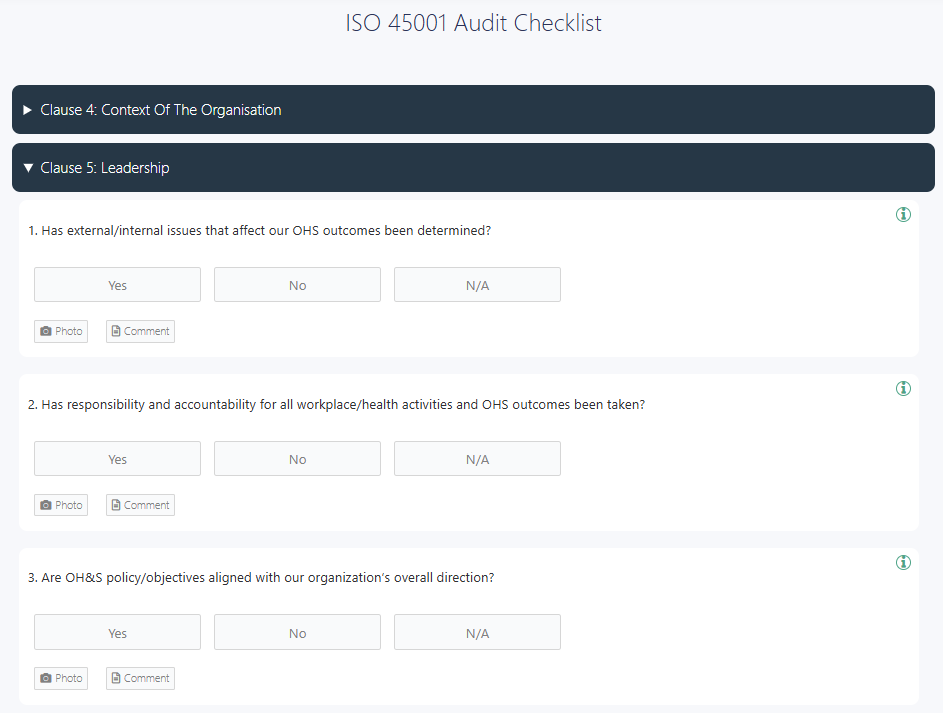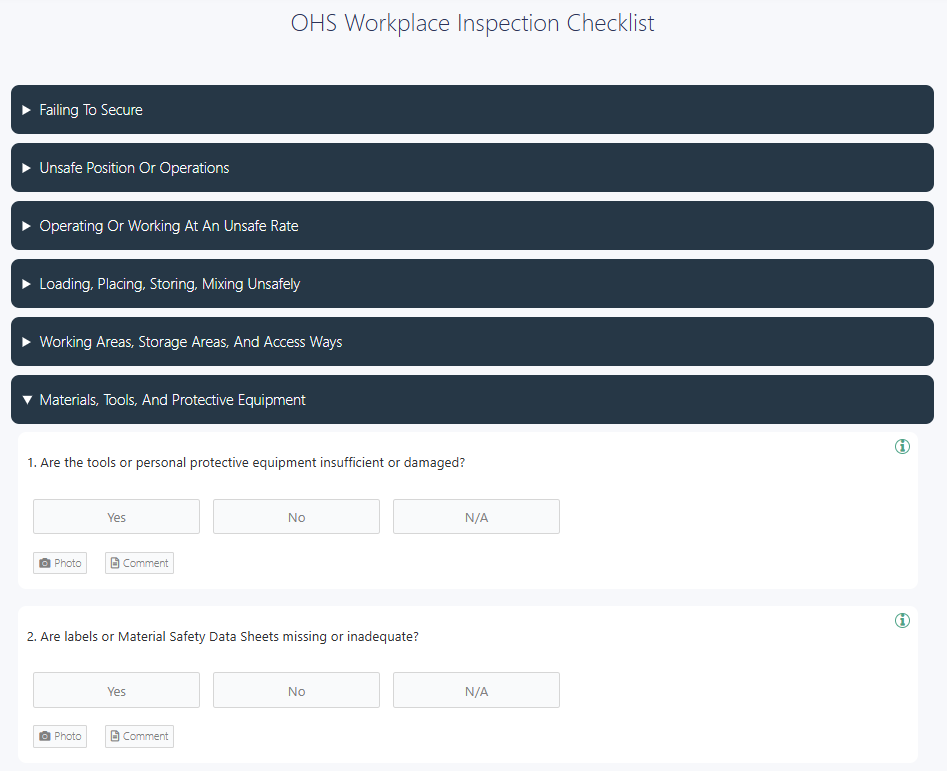Workplace safety matters, and not just because it’s a legal obligation. At the end of the day, it’s about making sure everyone goes home safely. That’s where occupational health and safety (OHS) audits come in. Acting as workplace health check-ups, OHS audits assess your safety policies, everyday practices, and potential trouble spots before small issues become big problems.
This article will break down different OHS audit types, outline how to perform them, and explain why they’re worth the time and effort you invest. We have also included free downloadable & customizable checklists to help you get started.
- What are OHS Audits?
- How are OHS Audits Different from OHS Inspections and Risk Assessments?
- Types of OHS Audits
- Key Objectives and Benefits of OHS Inspections
- Essential OHS Requirements for Effective Audits & Inspections
- Steps to Perform Internal OHS Audits
- Streamline OHS Inspections & Audits with GoAudits
- Free Checklists to Simplify OHS Audits
What are OHS Audits?
An Occupational Health and Safety (OHS) audit is a systematic evaluation of an organization’s compliance with health and safety regulations and standards. It involves a thorough review of workplace policies, procedures, and on-the-ground practices to ensure they effectively mitigate risks and protect employees.
OHS audits and inspections serve several critical functions:
- Uncovering potential workplace hazards that may not be evident during routine operations, and implementing corrective actions.
- Ensuring compliance with applicable health and safety laws, regulations, and standards.
- Assessing the effectiveness of existing safety management systems and identifying areas for improvement.
- Providing insights that inform the development and enhancement of safety policies and procedures.
- Facilitating the process of obtaining and maintaining recognized safety certifications.
OHS compliance audits should be conducted at least annually. However, the frequency of OHS audits depends on multiple organizational and regulatory factors. They are:
- Industries with inherently higher risks, such as construction, manufacturing, and mining, require more frequent audits as these environments present greater hazards.
- Legal obligations often dictate minimum audit intervals. For instance, some jurisdictions or agencies, like OSHA, may mandate OHS compliance audits at specific intervals, such as every three years.
- Larger organizations or those with complex structures may face a wider range of safety risks, necessitating more frequent and systematic audit schedules.
- A history of workplace incidents, especially frequent or severe ones, indicates underlying issues. In such cases, increasing audit frequency can help identify root causes and prevent recurrence.
- Introducing new equipment, processes, or workflows can bring unknown risks. Audits after such changes can reassess and mitigate emerging hazards effectively.
Who Performs OHS Audits
OHS audits can be conducted either internally or externally.
OHS internal audits are conducted by employees within the organization, typically members of the health and safety team or other trained staff. Internal audits are generally more cost-effective and can be performed more frequently. However, it’s crucial to ensure that internal auditors maintain objectivity and impartiality to avoid potential conflicts of interest.
External audits are performed by independent third-party professionals or organizations specializing in OHS compliance. External audits are particularly beneficial for obtaining objective assessments, benchmarking against industry standards, and achieving or maintaining certifications such as ISO 45001. The independence of external audits enhances the credibility of the audit findings.
| Aspect | Internal Audits | External Audits |
| Conducted by | Employees within the organization | Independent third-party professionals |
| Objectivity | May be influenced by internal relationships; requires measures to ensure impartiality | High, due to independence from the organization |
| Cost | Generally lower, using existing internal resources | Higher, involving fees for external services |
| Frequency | Can be conducted regularly | Typically less frequent, often aligned with certification or regulatory schedules |
| Expertise Level | Familiarity with internal processes; may require additional training for specialized knowledge | Specialized knowledge and experience with current industry standards and regulations |
| Credibility | Valuable for internal assessments and improvements | Enhanced credibility with external stakeholders and regulatory agencies |
How are OHS Audits Different from OHS Inspections and Risk Assessments?
Understanding the distinctions between OHS audits, inspections, and risk assessments is crucial for maintaining a safe workplace.
OHS Inspections
They are more frequent, focused examinations of the workplace aimed at identifying immediate hazards and ensuring that safety measures are in place and functioning correctly. They concentrate on specific areas, equipment, or processes to detect potential risks that could lead to accidents or injuries. OHS inspections are often conducted by safety officers or supervisors and may occur daily, weekly, or monthly, depending on the organization’s needs and the nature of the work environment.
OHS Risk Assessments
They involve a thorough analysis of workplace activities to identify potential hazards, evaluate the associated risks, and determine appropriate control measures. OHS risk assessments are conducted during the planning stages of new processes, when introducing new equipment, or in response to changes in the work environment. The process includes identifying hazards, assessing the likelihood and severity of harm, and implementing measures to eliminate or control the risks.
| Aspect | OHS Audits | OHS Inspections | OHS Risk Assessments |
| Purpose | Evaluates overall compliance and effectiveness of safety systems | Identifies immediate hazards and ensures compliance with safety measures | Assesses risks associated with workplace activities and determines control measures |
| When Conducted | Periodically (e.g., annually or bi-annually) | Regularly (e.g., daily, weekly, monthly) | Before starting new processes, introducing new equipment, or after incidents |
| Who Conducts It | Internal or external auditors | Safety officers, supervisors, or designated personnel | Safety professionals, management, or employees trained in risk assessment |
| Focus | Comprehensive review of policies, procedures, and compliance | Checking workplace conditions, equipment, and safety practices | Identifying hazards, analyzing risks, and implementing preventive measures |
| Outcome | Report with findings, compliance status, and recommendations for improvement | Identification of hazards and corrective actions | Risk control measures and strategies to minimize workplace hazards |
| Role in OHS | Ensures the effectiveness of safety management systems | Provides ongoing hazard monitoring and compliance checks | Prevents incidents by managing risks |
While OHS audits, inspections, and risk assessments have distinct focuses and timings, they complement each other within an OHS management system. OHS risk assessments identify and mitigate potential hazards before they manifest. OHS inspections act as regular checks to ensure that control measures are effective and that new risks have not emerged. OHS compliance audits provide a periodic, comprehensive evaluation of the entire safety system, ensuring that the organization complies with all relevant regulations.
Types of OHS Audits
Understanding the different types of OHS audits can help you ensure a safer work environment and maintain regulatory compliance.
OHS Compliance Audits
Compliance audits focus on verifying adherence to applicable laws, regulations, standards, and internal policies related to occupational health and safety. They involve a thorough review of safety programs, employee training records, and documentation practices to ensure they meet legal requirements. Conducting regular OHS compliance audits helps identify areas where your organization may be at risk of non-compliance, allowing you to address issues and avoid potential legal penalties.
Program Audits
Program audits evaluate the design and effectiveness of specific safety programs within your organization. They assess whether these programs are achieving their intended safety outcomes and identify areas for improvement. Program audits provide insights into the practical implementation of safety initiatives by analyzing individual components and gathering input from employees. These audits are performed to ensure safety programs are well-designed and effectively executed.
Management System Audits
Management system audits combine elements of program and OHS compliance audits to assess how well the safety management system aligns with company policies and regulatory standards. They typically involve reviewing documentation, conducting employee interviews, and observing workplace practices to provide a holistic view of the effectiveness of your safety management system.
Key Objectives and Benefits of OHS Inspections
OHS inspections offer numerous benefits that contribute to the overall well-being of employees and the efficiency of organizational operations.
- Regular OHS inspections ensure adherence to laws and regulations, helping organizations avoid legal penalties and uphold their reputations.
- OHS inspections help identify potential hazards, allowing for the implementation of control measures to mitigate risks. This significantly reduces workplace injuries and illnesses.
- Analyzing key performance indicators (KPIs) during OHS inspections enables benchmarking against industry standards. This highlights areas for improvement and tracks the effectiveness of safety initiatives over time.
- OHS inspections identify trends and patterns that inform long-term improvements and assess the adequacy of existing safety policies and protocols.
- Effective OHS inspections contribute to cost reduction by decreasing workplace accidents, leading to fewer compensation claims and reduced legal risks.
- OHS inspections demonstrate a commitment to employee well-being, enhance morale and productivity, encourage proactive participation in maintaining a safe workplace, and reinforce a safety culture within the organization.
Essential OHS Requirements for Effective Audits & Inspections
Here are the key requirements for conducting OHS audits and inspections.
Risk Assessment and Hazard Identification
Regular risk assessments identify and mitigate workplace hazards. The frequency of these assessments varies based on the organization’s nature, workplace changes, and specific regulations. While some workplaces conduct risk assessments monthly, others may do so semi-annually or annually.
Common hazards identified during OHS risk assessments include:
- Physical Hazards: Machinery-related injuries, noise, and temperature extremes.
- Chemical Hazards: Exposure to harmful substances like acids, solvents, or fumes.
- Biological Hazards: Risks from bacteria, viruses, or other pathogens.
- Ergonomic Hazards: Issues arising from repetitive movements or improper workstation setups.
- Psychosocial Hazards: Stress, workplace violence, or harassment.
GoAudits offers a wide range of free checklists that can help you document and assess different types of risks and take corrective measures accordingly.
- Internal Audit Risk Assessment Checklist
- Job Risk Assessment Template
- Fire Risk Assessment Checklist
- Ergonomic Risk Assessment Template
- Manual Handling Risk Assessment Checklist
- Confined Space Risk Assessment Form
- WHS Risk Assessment Template
- Noise Risk Assessment Template
- Risk Assessment for Allergies in the Workplace Template
- DSEAR Risk Assessment Checklist
- Hazard Identification Form
Prioritizing these risks involves evaluating their severity and likelihood. Hazards with high severity and probability, or those affecting numerous workers, should receive immediate attention.
👉 Use job hazard analysis software to conduct thorough and more efficient job hazard assessments and identify risks across different roles and processes.
Occupational Health and Safety Management System (OHSMS)
An OHSMS provides a structured framework for managing health and safety risks. ISO 45001 is the internationally recognized standard for OHSMS, applicable to organizations of all sizes and industries. It emphasizes leadership engagement, context analysis, and risk-based thinking, aligning with other ISO management system standards.
👉 Learn more about conducting ISO 45001 audits to evaluate your OHSMS against ISO 45001 requirements, maintain certification, and strengthen compliance.
GoAudits offers a free internal OHSMS audit checklist to help you assess and evaluate your occupational health and safety plans, policies, and programs, as well as their implementations. With an ISO 45001 audit checklist, you can conduct a comprehensive audit of your OHSMS and prepare for ISO 45001 certification.
Compliance with Laws and Standards
It involves understanding applicable regulations and identifying relevant local, national, and international OHS laws. Implementing necessary controls can help establish measures to meet legal obligations and safeguard employees. Regularly reviewing and enhancing OHS practices can ensure ongoing compliance and effectiveness.
Employee Training and Awareness
Effective safety programs begin with thorough employee training, so they can perform their tasks safely. Training should cover hazard recognition, safe work practices, and emergency procedures, and instructing workers on how to report injuries, illnesses, incidents, and concerns ensures that issues are promptly addressed.
Consultation and Worker Participation
Involving workers in OHS planning, implementation, and evaluation processes through regular safety meetings and collaborative discussions is essential. Employees often have firsthand knowledge of workplace hazards and can provide valuable insights into potential risks and solutions. Establishing an open-door policy encourages workers to communicate safety and health concerns without fear of retaliation.
Incident Reporting and Investigation
A robust system for reporting and investigating incidents encourages employees to report injuries, illnesses, close calls, and unsafe conditions, enabling timely interventions. Employers should respond promptly to reports, involve workers in finding solutions, identify root causes, implement corrective measures, and communicate actions taken.
👉 Find out how a mobile incident reporting app and near miss reporting software can help you enhance the speed and accuracy of reporting near misses and workplace incidents, and prevent major accidents.
You can use these GoAudits checklists to report near misses, incidents, and accidents.
- Near Miss Incident Report
- Worksite Incident Report Checklist
- Incident Investigation Template
- Accident Investigation Checklist
Safety Measures
Implementing appropriate safety measures, such as providing personal protective equipment (PPE) and safety gear, is fundamental to protecting workers. Employers should assess workplace hazards to determine necessary PPE, ensure its proper use, and provide training on its correct usage. Regular inspections and maintenance of safety equipment are also essential to maintain their effectiveness.
👉 GoAudits offers a wide range of ready-to-use PPE checklist templates. You can use these free checklists to standardize PPE inspections and ensure all equipment remains safe for use.
Medical Evaluations and Health Monitoring
Regular medical evaluations and health monitoring help in early detection of work-related illnesses and conditions. Implementing health surveillance programs allows employers to assess the effectiveness of existing control measures and make necessary adjustments.
Steps to Perform Internal OHS Audits
Here are the key steps to perform an OHS internal audit:
1. Define the Scope
Begin by clearly identifying the areas and practices to be audited. This includes specifying work areas, facilities, equipment, materials, and departments. A well-defined scope ensures a focused and efficient audit process.
2. Assemble the Audit Team
Form a team with diverse expertise, including representatives from operations, engineering, maintenance, and health and safety departments. Involving personnel with varied perspectives enhances the audit’s comprehensiveness.
3. Review Documentation
Examine existing safety policies, compliance records, and previous audit reports. This review helps in understanding current practices and identifying areas needing improvement.
4. Create a Digital Checklist
Develop a checklist aligned with health and safety SOPs and safety procedures to guide the audit process. Using digital checklists can streamline data collection and analysis, ensuring consistency and efficiency.
👉 You can use the GoAudits OHS workplace inspection checklist and office OHS checklist to perform OHS internal audits.
5. Conduct the Internal OHS Audit
Use OHS app & software like GoAudits to perform the OHS internal audit. Inspect the identified areas, observe work practices, and interview employees. Document findings, note any non-conformities or potential hazards, and engage staff during the OHS internal audits to gain valuable insights into the practical implementation of safety procedures.
6. Review and Analyze Audit Results
Begin by thoroughly examining the audit findings to identify areas of non-compliance and potential hazards. Assess the severity and likelihood of incidents associated with each identified hazard to prioritize corrective actions effectively.
👉 Tracking safety performance metrics is essential when evaluating audit findings. Learn how OSHA TRIR calculations help you measure and compare incident rates accurately.
7. Prepare and Share the Audit Report
Document the audit outcomes comprehensively, detailing identified issues, their potential impact, and recommended corrective measures. Distribute this report to relevant stakeholders, including management and safety committees, to ensure transparency and collective decision-making.
8. Implement Corrective Actions
Develop a structured action plan addressing the prioritized risks. Assign responsibilities and set clear timelines for each corrective measure. Effective implementation is vital for mitigating identified hazards and enhancing workplace safety.
9. Follow Up on Findings
Regularly monitor the progress of implemented actions to verify their effectiveness. Conduct follow-up audits or inspections to ensure that corrective measures are sustained and that no new issues have arisen.
Streamline OHS Inspections & Audits with GoAudits
Admin and paperwork for OHS inspections and audits get in the way of getting things done. Who wants to spend hours filling out forms that likely will get filed without reading? GoAudits safety inspection app is an all-in-one digital solution to simplify workplace inspections, automate reporting, and optimize workflows. GoAudits reduces time spent on audits and reports, links up the team members in real time, and helps ensure follow-up.
Here’s how:
- Speed through inspections up to 5x faster with checklists that actually match your workplace and OHS standards. And yes, they work offline even when your Wi-Fi doesn’t.
- Snap photos of issues, mark them up, and automatically add location data and signatures on the spot. Now, no more “they said this” and “they said that” when something needs fixing.
- Generate reports instantly after your OHS inspections. No more typing up notes at your desk later. Share them with your team and move on with your day.
- Flag problems and assign fixes while you’re still on the inspection. Automatically nudge whoever’s responsible until it’s done.
- Set deadlines, send reminders, and track who’s taking care of what, so nothing falls through the cracks.
- Get the big picture with smart dashboards, spot patterns, track improvements, and make decisions based on actual data, not guesses.
- Dig into your safety data to find recurring issues, see where you’re making progress, and adjust your approach based on what’s really happening on the ground.
Free Checklists to Simplify OHS Audits
GoAudits offers a whole collection of free OHS inspection checklists. Simply sign up for free and start using them today:
- OHS Workplace Inspection Checklist
- Office OHS Checklist
- Internal OHSMS Audit (AS/NZS4801:2001)
- Occupational Health and Safety Checklist
- Small Business Health and Safety Checklist
- Workplace Inspection Checklist
- JSA Form – Job Safety Analysis Checklist
- Office Safety Inspection Checklist
- Workplace Safety Checklist
- Office Health & Safety Checklist
- Safety and Health Inspection Checklist
- Safety Audit Template
- Internal Audit Risk Assessment Checklist
- Office Hazards Checklist





